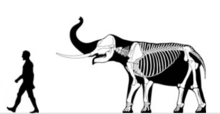Post by dinosauria101 on Mar 28, 2019 9:12:21 GMT 5
Sinomastodon hanjiangensis
Sinomastodon ("Chinese mastodont") is an extinct gomphothere genus (of order Proboscidea), from the Late Miocene to the Early Pleistocene deposits of south-east Asia (China, Japan, and Indonesia). It is not to be confused with the genus Mammut from a different proboscidean family, whose members are commonly called "mastodons". The animal was very similar to modern elephants with size ranging from 3.6 to 5.3 m. Several species are known from China, the best known being S. hanjiangensis from the Late Miocene and Early Pliocene of the Shanxi province. It is known from an incomplete skeleton of an adult (measuring 5.3 m) including maxilla, mandibles, teeth, tusks and other materials have been discovered. The Japanese species S. sendaicus described in 1924 from dentary materials from Pliocene deposits has been ascribed to the genus, as well as the species S. bumiajuensis (formerly Tetralophodon) from the late Pliocene of Java. One individual of S. hanjiangensis was a 30-year-old 2.07 metres (6.8 ft) tall and weighed 2.1 tonnes (2.1 long tons; 2.3 short tons).

Allosaurus fragilis
Allosaurus is a genus of carnivorous theropod dinosaur that lived 155 to 150 million years ago during the late Jurassic period (Kimmeridgian to early Tithonian). Allosaurus was a typical large theropod, having a massive skull on a short neck, a long tail and reduced forelimbs. Allosaurus fragilis, the best-known species, had an average length of 8.5 m (28 ft), with the largest definitive Allosaurus specimen (AMNH 680) estimated at 9.7 meters (32 feet) long, and an estimated weight of 2.3 metric tons (2.5 short tons). As with dinosaurs in general, weight estimates are debatable, and since 1980 have ranged between 1,500 kilograms (3,300 pounds), 1,000 to 4,000 kg (2,200 to 8,800 lb), and 1,010 kilograms (2,230 pounds) for modal adult weight (not maximum). Using the subadult specimen nicknamed "Big Al", researchers using computer modelling arrived at a best estimate of 1,500 kilograms (3,300 lb) for the individual, but by varying parameters they found a range from approximately 1,400 kilograms (3,100 lb) to approximately 2,000 kilograms (4,400 lb).

Credit to Wikipedia
Sinomastodon ("Chinese mastodont") is an extinct gomphothere genus (of order Proboscidea), from the Late Miocene to the Early Pleistocene deposits of south-east Asia (China, Japan, and Indonesia). It is not to be confused with the genus Mammut from a different proboscidean family, whose members are commonly called "mastodons". The animal was very similar to modern elephants with size ranging from 3.6 to 5.3 m. Several species are known from China, the best known being S. hanjiangensis from the Late Miocene and Early Pliocene of the Shanxi province. It is known from an incomplete skeleton of an adult (measuring 5.3 m) including maxilla, mandibles, teeth, tusks and other materials have been discovered. The Japanese species S. sendaicus described in 1924 from dentary materials from Pliocene deposits has been ascribed to the genus, as well as the species S. bumiajuensis (formerly Tetralophodon) from the late Pliocene of Java. One individual of S. hanjiangensis was a 30-year-old 2.07 metres (6.8 ft) tall and weighed 2.1 tonnes (2.1 long tons; 2.3 short tons).

Allosaurus fragilis
Allosaurus is a genus of carnivorous theropod dinosaur that lived 155 to 150 million years ago during the late Jurassic period (Kimmeridgian to early Tithonian). Allosaurus was a typical large theropod, having a massive skull on a short neck, a long tail and reduced forelimbs. Allosaurus fragilis, the best-known species, had an average length of 8.5 m (28 ft), with the largest definitive Allosaurus specimen (AMNH 680) estimated at 9.7 meters (32 feet) long, and an estimated weight of 2.3 metric tons (2.5 short tons). As with dinosaurs in general, weight estimates are debatable, and since 1980 have ranged between 1,500 kilograms (3,300 pounds), 1,000 to 4,000 kg (2,200 to 8,800 lb), and 1,010 kilograms (2,230 pounds) for modal adult weight (not maximum). Using the subadult specimen nicknamed "Big Al", researchers using computer modelling arrived at a best estimate of 1,500 kilograms (3,300 lb) for the individual, but by varying parameters they found a range from approximately 1,400 kilograms (3,100 lb) to approximately 2,000 kilograms (4,400 lb).

Credit to Wikipedia


